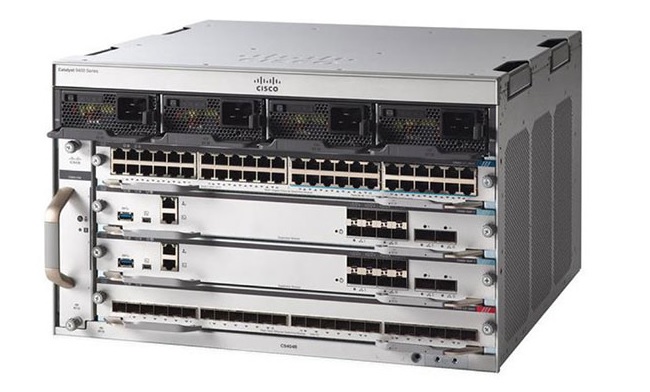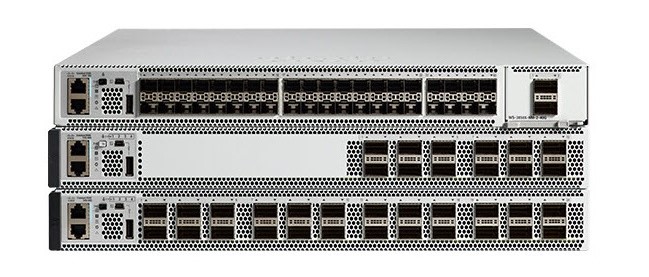
The world is rapidly changing, and your network must keep up. Cisco is transitioning the legacy Catalyst platforms to the new Cisco Catalyst 9000 switches as we approach the next era of networking. These switches are intended to serve as the cornerstone for intent-based network architecture and a revolutionary networking methodology. So what’s the difference between Cisco Catalyst 9400 and Catalyst 9500? How to choose between them?
Cisco Catalyst 9400 Series
Cisco Catalyst 9400 Series Switches are the next generation of Cisco Catalyst 9000 family enterprise-class modular access and aggregation switches. With a centralized switching design capable of handling up to 9 Tbps system bandwidth and unsurpassed permanent PoE power delivery, these switches guarantee unrivaled investment protection.
With features like NSF/SSO, In-Service Software Upgrade (ISSU), uplink resiliency, and N + 1/N + N redundancy with modular power supply, the switch series provides state-of-the-art high availability.
The Catalyst 4500-E series is being renamed Catalyst 9400. Cisco Catalyst 9400 switches are a modular enterprise switching access and distribution platform designed for security, IoT, and cloud. The Cisco Catalyst 9400 provides more advanced features than the Catalyst 9200 and 9300, such as StackWise Virtual, BGP routing capabilities, MACSec-256, MPLS functionalities, and so on.
| Feature | C9400-SUP-1 | C9400-SUP-1XL | C9400-SUP-1XL-Y |
| Cisco Catalyst C9404R chassis | 80 Gbps/slot | 240 Gbps/slot | 240 Gbps/slot |
| Cisco Catalyst C9407R chassis | 80 Gbps/slot | 120 Gbps/slot | 120 Gbps/slot |
| Cisco Catalyst C9410R chassis | 80 Gbps/slot | 80 Gbps/slot | 80 Gbps/slot |
RS recommends: C9400-PWR-3200AC, C9400-LC-48U, C9400-DNA-E-3Y
Cisco Catalyst 9500 Series
Cisco has combined and improved the Catalyst 4500-X and Catalyst 3850 fiber switches to the Cisco Catalyst 9500 series. Cisco Catalyst 9500 Series switches are the next generation of Cisco Catalyst 9000 family fixed-core and aggregation layer switches. The Cisco Catalyst 9500 series offers up to 6.4 TBps in a small, high-density package. They’re also the first 10/25/40 and 100 Gigabit Ethernet switches designed specifically for enterprise applications, with unrivaled table scaling and buffering.
Cisco Catalyst 9500 Series switches are the first 100, 40 and 25 Gigabit Ethernet feature-rich switches designed for enterprise campuses, with unparalleled table sizes (MAC, route, and Access Control List [ACL]) and buffering for enterprise applications. Nonblocking 100 Gbps Quad Small Form-Factor Pluggable (QSFP28), 40 Gbps (QSFP), 25 Gbps (SFP28), and 10 Gbps (SFP+) switches with granular port density are available for a variety of campus requirements.
These switches also support critical services for use in the campus core, as well as foundational software, hardware, and system high availability. There are four platforms in the Catalyst 9500 Series:
| Platforms | C9500-32C, C9500-32QC | C9500-24Y4C, C9500-48Y4C | C9500-12Q, C9500-24Q | C9500-16X, C9500-48X |
| Features | -32 ports of 100G and 40G with rich campus features
-QSFP+ Technology -Secure segmentation with SD-Access -MPLS L2/L3 VPNs, MVPN |
-24 and 48 ports of 25 G with rich campus features
-SFP28 Technology -Secure segmentation with SD-Access -MPLS Level 2/3 VPNs, MVPN |
-32 ports of 40 G with rich campus features
-QSFP+ Technology -10/40 G uplinks -Secure segmentation with SD-Access -MPLS Level 2/3 VPNs, MVPN |
-16 to 40 ports of 1/10 G with rich campus features
-SFP/SFP+, 8 x 1/10 G or 2 x 40 G uplinks -Secure segmentation with SD-Access -MPLS Level 2/3 VPNs, MVPN |
RS recommends: C9500-48Y4C-E, C9500-48Y4C-A, C9500-24Y4C-E, C9500-24Y4C-A
Catalyst 9400 vs. Catalyst 9500
The differences between Catalyst 9400 and Catalyst 9500 can be compared in the following aspects: type, positioning, uplinks, downlinks, high availability capabilities, switching capacity and so on. We can see on the table below that the Catalyst 9400 is the replacement for Catalyst 4500-E and equivalent switches; Catalyst 9500 is the replacement for Cisco Catalyst 4500-X Series, Cisco Catalyst 3850 10G fiber (48P), Cisco Catalyst 6880-X and Cisco Catalyst 6840-X. For more details, let’s look at the table below.
| Parameter | Catalyst 9400 | Catalyst 9500 |
| Type | Chassis Based | StackWise |
| Positioning | Core/Aggregation/Access | Core/Aggregation |
| Replacement for | Catalyst 4500-E and equivalent switches | Cisco Catalyst 4500-X Series
Cisco Catalyst 3850 10G fiber (48P) Cisco Catalyst 6880-X Cisco Catalyst 6840-X |
| 100G support | No | Yes |
| POE support | Yes | No |
| Dedicated Supervisor slot | Yes | No |
| Uplinks | 1 Gbps
10 Gbps 25 Gbps 40 Gbps |
1/10 Gbps
25 Gbps 40 Gbps 100 Gbps |
| Downlinks | Multigigabit
1 Gbps copper 1 Gbps SFP 10 Gbps SFP+ Cisco UPOE PoE+ options |
100 Gbps QSFP28
40 Gbps (QSFP) 25 Gbps (SFP28) 10 Gbps (SFP+) |
| High availability capabilities | ISSU
NSF/SSO Uplink Resiliency N+1/N+N redundancy for power supplies and PoE. |
Patching
Graceful Insertion and Removal Nonstop Forwarding with Stateful Switchover Redundant platinum-rated power supplies and fans |
| Switching capacity | Up to 9 Tbps | Up to 6.4 Tbps |
If you want to order Switches, welcome to visit: Shop Switches at Router-switch.com .
Related Topics:
Cisco Switches Replacement List: Cisco 100 series and 250 series
Cisco Switches Replacement List: Cisco 350 series and 550X series
Brand Switches Comparison: Cisco Switches vs Huawei Switches
Cisco SG350 vs. CBS350-What’s the difference?
Reference:
Blog. Differences in the Catalyst 9000 Series Switch Models. [online]




